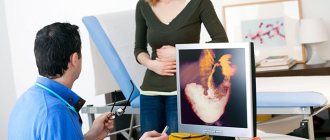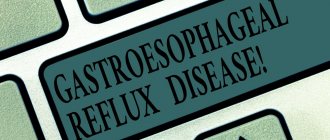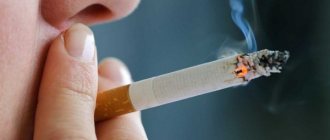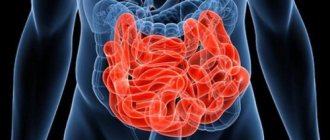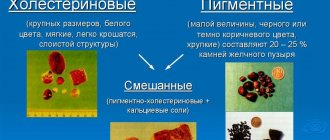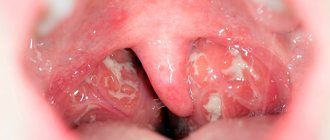A little about the terms
The esophagus is divided into three regions. Its lower part is called distal. Esophagitis is an inflammatory process. Distal reflux esophagitis is inflammation of the same lower area. With distal inflammation, sphincter dysfunction occurs (weakening).
If cardia insufficiency occurs, masses are thrown into the distal region of the esophagus, and this negatively affects its soft tissues. The reflux process itself is called reflux.
At the initial stage of inflammation, it is enough to go on a light diet for the ailments to go away.
According to the results of the previously listed factors, cardia failure occurs against the background of esophagitis. If present, significant complications may occur. It is recommended to visit a gastroenterologist at the first unpleasant symptoms in the esophagus. Properly prescribed treatment will help quickly prevent the spread of distal esophagitis.
There are three stages of development of this disease:
- 1st degree cardia insufficiency – incomplete closure of the sphincter, presence of air belching;
- weakened sphincter type 2 - protrusion of the soft tissues of the stomach, which subsequently creates obstruction;
- the third stage is the complete opening of the sphincter, the development of esophagitis is observed.
Signs
Signs of the disease may differ depending on the degree of cardia insufficiency.
- First degree. At this stage, frequent belching of air appears.
- Second degree. It is expressed by constant belching, both air and stomach contents, painful sensations, heartburn, irritation of the stomach walls, and general weakness.
- Third degree. Symptoms become more pronounced. Severe heartburn is observed, regardless of the products used, pain in the epigastric zone, pain during meals, nausea and vomiting, belching with air or the smell of food that was consumed, possibly an increase in body temperature as a result of the inflammatory process.
Distal reflux esophagitis
The inflammatory process in the esophagus is characterized by three types - total, proximal, distal. The first covers the entire mucosal area, the second takes over the beginning of the organ, the third affects the lower part.
The main reason for its development is cardia failure. This is a weak functioning of the upper gastric valve. When it opens, the contents are thrown into the esophagus, which oxidizes its soft tissues.
Various factors can provoke such a complication: infections, damage to the esophageal mucosa, stress, medications, junk food, severe cough, pregnancy, lifting heavy objects, gastritis.
Some patients do not pay attention to heartburn. At some point, they try to get rid of it with the help of soda and medications, thereby worsening the situation. While this is happening, the inflammation becomes chronic - distal reflux penetrates into the deep layers of soft tissue.
Regular reflux of masses into the lower esophagus from the cardia provokes a burn of the mucous membrane. Then erosions and ulcers begin to grow. In the most advanced cases of reflux esophagitis, diffuse peritonitis forms. The initial stage of complications is called catarrhal reflux esophagitis.
Reviews
Dear readers, your opinion is very important to us - therefore, we will be happy to provide feedback on esophagitis and cardia insufficiency in the comments, this will also be useful to other users of the site.
My husband complained all the time about pain in his chest, and the pain was especially intensified after eating. They thought that angina pectoris was developing, after examination they diagnosed reflux - esophagitis. The disease can be cured if you consult a doctor in time. My husband completed a course of therapy, is on a diet, and his condition is improving.
As a result of constant haste when eating, excessive use of coffee, fast food, I developed gastric cardia insufficiency. Serious pathology, however, can be treated with medications if it is not neglected. Operating methods are not that safe.
Catarrhal esophagitis (CE)
Clinical manifestations of FE are characterized by painful spasms of varying intensity throughout the esophagus. Pain can occur both after eating and when swallowing food. Burning in the chest, heartburn, vomiting are companions of catarrhal inflammation. Pain attacks may radiate to the shoulder blades (in this case, it is necessary to be examined by a cardiologist). Regurgitation and difficulty with the swallowing reflex are also observed.
The diagnosis of FE is written after all the necessary examinations - fibrogastroscopy (assessment of bleeding), manometry (pressure in the abdominal cavity), pH-metry (acidity). Some patients are prescribed barium X-ray (for the presence of a hernia). It is also necessary to undergo tests, according to which a specialist assesses the severity of the inflammatory process and possible anemia.
With catarrhal esophagitis, there are no ulcers, erosive formations, films, or layers.
Treatment of CE (catarrhal esophagitis) is carried out using conservative methods. To begin with, diet No. 1 is prescribed. Drugs are prescribed to alleviate the general condition - Rennie, phosphalugel. Proton pump inhibitors - omez. It is necessary to take enveloping agents - de-nol. If severe pain is observed, it is recommended to take a herbal pain reliever - no-spa. Medicinal plants can also relieve mild symptoms of CE (catarrhal esophagitis).
Note that treatment with traditional medicine is not recommended for cardia insufficiency of degrees 2 and 3.
If for some reason bleeding begins, you should call an ambulance. In this case, surgical intervention is indicated. As a rule, catarrhal reflux can be stopped at an early stage.
With adequate operation of the cardia socket, the valve opens at the moment the product passes into the stomach. During these seconds, the tone of the sphincter changes, then returns to normal - the sphincter closes as soon as the food is in the stomach. If this process does not occur, heartburn and all associated symptoms occur.
Diagnostics
In order to confirm the diagnosis and prescribe appropriate treatment and diet, the gastroenterologist conducts laboratory and instrumental diagnostics. It is mandatory to appoint:
- X-ray of the esophagus using a contrast agent;
- esophagoscopy;
- esophagomanometry;
- pH level monitoring.
Carrying out esophagoscopy
Based on the diagnostic results, an individual treatment plan is drawn up, including medications, diet and, if necessary, physical procedures.
Treatment of a weakened sphincter
Cardia insufficiency is treated with a balanced diet. This concept means regimen and small portions. It is advisable not to rush while eating. It is not recommended to take a lying position after a meal; it is better to sit or walk for a couple of hours. When diagnosed with esophagitis, the menu should include liquid porridges and low-fat soups.
The main principle of therapeutic therapy is to protect the soft tissues of the esophagus from harmful effects and avoid irritants (chemical, thermal). That is why it is strictly forbidden to eat hot and cold foods. The patient should also eat a lot of fruits and drink still water. From your usual diet, exclude foods that irritate the soft tissues of the esophagus: chocolates, alcohol, strong tea, coffee, smoked meats, marinades.
Late meals are taken a few hours before the night's rest. In general, treatment recommendations imply restrictions in the form of exclusion of tight belts. You need to rest with the head of the bed raised (15 cm). You should not overwork, tilt your body forward.
If cardia insufficiency is severe, you should change your place of work (lifting heavy objects).
Drug treatment is usually not required. Medicines are prescribed in case of patient complaints and suspected catarrhal esophagitis.
Treatment of cardia insufficiency (open esophageal valve) can be carried out both in a day hospital and on an outpatient basis. Often, a gastroenterologist recommends visiting a sanatorium with a therapeutic focus, where the patient will be provided with all the necessary assistance. On vacation, specialists will select physical therapy, create a diet and normalize psychological balance.
Lifestyle
Before starting treatment for reflux esophagitis, it is necessary to get rid of those addictions and habits that led to cardia insufficiency. This means that you need to listen to simple recommendations and strictly follow all medical advice:
- Diet therapy is one of the main components in the treatment of gastrointestinal patients. Patients must strictly adhere to the recommended diet, excluding all prohibited foods from the menu. Food should be warm, boiled (or steamed), soft. You need to eat regularly, often, in small portions.
- A patient with EC must avoid physical and mental stress and stressful situations in every possible way. However, you cannot completely give up physical activity (you can visit the pool, go for walks).
- It is necessary to ensure a full 8 hours of sleep at night. It is better to sleep on a special wedge-shaped pillow for GERD, one end of which is raised twenty centimeters above the level of the bed, which prevents the backflow of gastric contents and allows you to sleep correctly.
- Quit alcohol and smoking.
All these tips must be followed even after the clinical manifestations have subsided, so they are a prevention of repeated exacerbations.
Treatment of erosive esophagitis should be combined with adherence to a rational diet and daily routine. If you follow these rules, you can overcome the disease and cope with unpleasant symptoms.
Regardless of the stage of the disease, the patient must follow the following rules:
- meals should be exclusively fractional, and the break between meals should not exceed three hours;
- the last meal should be 3 hours before bedtime;
- fatty, hot, cold foods, fast food, baked goods, sweets are excluded;
- Alcohol, coffee, and sparkling water are prohibited;
- food should be boiled, steamed, stewed, baked;
- a patient diagnosed with erosive distal esophagitis is prohibited from overeating.
Such a person is prohibited from wearing tight underwear or belts. After eating, you should not lie down: you need to take slow walks. You need to sleep on two pillows.
So, catarrhal esophagitis can be effectively treated if it is detected early and consulted with a therapist. In advanced forms of pathology, surgery is necessary. Maintaining a healthy lifestyle will help prevent the occurrence of such a disease.
The formation of erosive and ulcerative foci in the esophagus is provoked by:
- reflux of acidic stomach contents into the esophagus - this process is characterized by reflux esophagitis, hyperacid gastritis and gastric ulcer;
- taking aggressive substances that cause burns to the esophageal mucosa;
- surgical interventions on the chest, examination of the gastrointestinal tract using a probe (fibrogastroduodenoscopy, sampling of gastric juice and bile);
- long-term use of certain medications;
- mechanical damage (fish bone, ingestion of small hard objects);
- various infections (fungal, bacterial, viral);
- allergic reactions;
- congenital malformation of the esophagus in children (usually stenosis of the cardiac part of the stomach).
The occurrence of acute or exacerbation of chronic esophagitis can be provoked by a nervous shock, an error in diet (a festive feast or eating fried/spicy food and, as a result, an increase in stomach acidity), the habit of smoking on an empty stomach and drinking alcohol.
Distal reflux esophagitis: what is it?
Reflux esophagitis is a disease in which, due to the constant reflux of gastric juice into the esophagus, inflammation of the latter begins. The lesion can be total, proximal or distal. In the first case, it covers the entire esophagus, in the second – its upper part, and in the third – the lower part, adjacent to the stomach.
It is distal reflux esophagitis that is most often diagnosed in patients. According to statistics, every fifth inhabitant of the planet suffers from it. This form of the disease is more difficult to identify than others, and treatment usually takes a long time.
Damage to the lower esophagus can be acute , subacute or chronic . Also distinguished are catarrhal, erosive, edematous, hemorrhagic, pseudomembranous, necrotic, allergic, biliary and exfoliative reflux esophagitis of the distal type. Information about the most common varieties will be given below.
Mechanism of disease development
Regularly refluxing stomach contents into the esophagus leads to tissue damage . At the initial stages, the mucous membrane becomes loose, and a slight smoothing of the folds is observed. There is already erythema in the form of foci, but it is still weakly expressed.
small erosions appear on the mucous membrane of the lower part of the esophagus The lesion covers in general one tenth of the tissues.
The next stage is the appearance of many erosions and ulcers. Some of them connect with each other, and quite large areas of lesions are formed. They are often covered with pus. In some places, tissue death (necrosis) is recorded. More than 50% of the area of the lower esophagus is affected.
In accordance with the stages described above, four stages of disease development are distinguished. At earlier stages, the disease responds well to treatment. In the later stages, it is much more difficult to deal with it, and the likelihood of serious complications is high.
Degrees of development
The catarrhal form of inflammation has several degrees of severity with characteristic features:
- 1st degree - the appearance of small localized lesions on the mucous membrane. There may be several or one up to 5 mm in diameter. No fusion of lesions is observed. It is often asymptomatic.
- Stage 2 - there are several defective zones larger than 5 mm. Foci of inflammation gradually merge, but do not yet affect the entire mucous membrane. The first symptoms appear - heartburn, burning pain in the chest.
The progression of esophagitis can reach the extent of damage to more than 2/3 of the esophageal mucosa.
- 3rd degree - more than ¾ of the mucous membrane is inflamed. Symptoms become more pronounced and appear regardless of food intake.
- Stage 4 - damage to more than 75% of the organ surface. This stage is characterized by the development of complications in the form of the appearance of chronic ulcers or cicatricial stricture of the esophageal lumen.
Symptomatic picture
The insidiousness of distal reflux esophagitis is that it often does not make itself felt for a long time. The asymptomatic course distinguishes it from other forms - total and proximal. Signs usually appear in the later stages. The disease manifests itself :
- severe heartburn ;
- increased salivation (especially during night sleep);
- chest pain similar to heart pain;
- hoarseness and hoarseness of voice;
- persistent dry cough;
- hiccups;
- belching with a sour or bitter taste;
- bad breath.
Usually, the presence of such signs already forces a person to seek help from a doctor , since his life becomes unbearable. And, as a rule, the third or fourth stage is diagnosed.
Catarrhal distal reflux esophagitis
The catarrhal form of distal reflux esophagitis can be considered the initial stage of the disease (first stage). It is often acute and occurs after chemical or thermal burns, drinking low-quality alcohol, strong coffee or food that injures the mucous membrane. It manifests itself as belching of air, a sour taste in the mouth, heartburn, which occurs in the very first seconds after starting a meal, and in some cases, reflex vomiting.
Lack of treatment leads to chronic catarrhal reflux esophagitis. The disease can be detected using gastroesophagoscopy . Adequate methods of control will quickly eliminate the lesion.
When diagnosed with distal catarrhal reflux esophagitis, cardia insufficiency occurs in three stages - incomplete closure of the sphincter, its complete opening and protrusion of the soft tissues of the stomach.
Distal erosive reflux esophagitis: what is it?
The erosive form is the next stage in the development of the disease after catarrhal. With it, erosions already appear on the mucous membrane, the tissues become very loose. The affected area increases rapidly as gastric juice continues to negatively affect existing wounds.
The patient suffers from heartburn and experiences severe pain in the chest and esophagus. There are also belching with a taste of blood, vomiting with red impurities. The patient feels overwhelmed and weak. Due to internal bleeding, he develops anemia. Treatment of the erosive form is more serious and lengthy.
When distal erosive reflux esophagitis is diagnosed, grades a, b, c, d differ in the areas of damage to the mucous membrane and a different number of defects.
Terminal form
Pathology often develops in newborns who have suffered asphyxia and oxygen deficiency in the womb. Terminal esophagitis is characterized by damage to the mucous membrane with multiple hemorrhages (point hemorrhages) and erosions . Symptoms of the terminal form in children:
- severe, frequent hiccups;
- regurgitation with gushing vomiting;
- unstable sleep due to stomach pain;
- weight loss due to loss of appetite.
In adults additionally appear:
- pain and heartburn in the chest, aggravated by lying down;
- belching of undigested food;
- whitish coating on the tongue;
- nausea ending in vomiting.
https://youtu.be/EzK8tVX9Eq4
Distal esophagitis and cardiac failure
Distal reflux esophagitis occurs against the background of cardiac insufficiency. Cardiac insufficiency is a malfunction of the valve located on the border between the esophagus and the stomach.
Normally it should close tightly. When this does not happen, the contents of the stomach are easily thrown into the esophagus. It is the insufficiency of the cardia that is considered the main cause of the development of distal reflux esophagitis.
The anomaly can be caused:
- obesity;
- habit of eating at night;
- stomach tumors and other gastrointestinal diseases;
- increased pressure in the peritoneum;
- reduced immunity.
Distal reflux esophagitis may have other causes. Often they need to be treated first. But be that as it may, you cannot do without the help of specialists. The sooner diagnosis is made and treatment is started, the better the prognosis.
Diet
During the treatment period, it is necessary to follow a special diet. You should take food in portions 5 times a day, do not overeat, the last meal should be no later than 4 hours before bedtime. You need to give up bad habits, quit smoking, avoid chewing gum and candy.
It is imperative to monitor your weight and not go to bed immediately after eating in order to avoid disruptions in the digestion process.
The following should be excluded from the diet:
- Coffee, spicy, hot, spicy dishes;
- Onions, peppers, strong tea, carbonated drinks;
- Fried and fatty foods;
- Butter, chocolate, fast food;
- Watermelon, pineapples, the juice of which negatively affects the walls of the stomach;
- Cheese products, sour cottage cheese and whole milk;
- Lard, ham, offal;
- Garlic, tomatoes;
- Desserts with high calorie content;
- Cream soups, sauces, gravies.
It is useful to use olive oil, porridges from various cereals, which envelop the walls of the stomach and help normalize the functioning of the gastrointestinal tract. Porridge should be cooked exclusively in water. Bananas, corn, apples, mangoes (without peel) are useful. These fruits activate the digestion process, remove toxins from the body, and improve immunity. It is recommended to use herbal infusions to reduce acidity.
You need to consider lifestyle. It is not recommended to wear tight clothes or belts, it is necessary to avoid stressful conditions, often walk in the fresh air, organize picnics in nature, and avoid a sedentary lifestyle. The pillow should be raised so that it is slightly above body level. This helps eliminate heartburn and reduce pressure on the stomach. It is imperative to maintain a sleep schedule, since healthy sleep has a positive effect on the condition of the entire body.
Relapse Prevention
Catarrhal esophagitis has a risk group that includes men over 45 years of age, smokers, people who have suffered from heartburn for a long period, who have had cases of heartburn at night, as well as overweight people.
The goal of preventing esophagitis is to prevent the disease and its relapses. Prevention measures are:
- maintaining a healthy lifestyle (exclude smoking and alcohol);
- compliance with dietary rules (do not overeat, do not eat fried, salty, spicy foods, do not eat at night);
- reduce body weight (if BMI is more than 30);
- exclude uncontrolled use of medications that cause reflux (sedatives, tranquilizers, drugs, nitrates);
- suppression of heartburn attacks, because this is a signal of increased acidity, which leads to damage to the mucous membrane.
Prevention is successful if the number of exacerbations has decreased, the severity has decreased, and no complications have been identified.
If the diagnosis is incorrect or the disease is advanced, complications may arise: Barrett's esophagus, cicatricial stenosis, wall perforations, purulent inflammation. Some will require surgery.
In patients with catarrhal esophagitis, a high percentage of recovery is observed, provided that the recommendations are followed, qualitative changes in living conditions and the elimination of risk factors.
Folk remedies
Their use can only help at the initial stage. In other cases, this type of therapy should be perceived as auxiliary. The most effective means:
- Chamomile. Strong antiseptic effect. It is recommended to brew it as tea and drink it at least 5 times a day before meals.
- Flax seeds. They are poured with boiling water and left for several hours. Drink 1 tbsp. l. at least 3 times a day before meals.
- Honey. It quickly fights inflammatory processes, but is also a strong allergen. Before using it, you need to make sure there is no allergy. It is recommended to eat 50 g of pure honey per day or dissolve it in warm water. Consume honey between meals, 2 hours before or after meals.
- Sea buckthorn oil. It has an enveloping, anti-inflammatory and antiseptic effect. Drink it 3 times a day, 1 tbsp. l. before meals, the first dose should be in the morning.
Symptoms
Alarm signals, when they appear, you need to contact a gastroenterologist, are:
- Pain when swallowing and when food passes through the esophagus (cause: swelling of the mucous membrane).
- Occasional feeling of food getting stuck.
- The occurrence of raw pain behind the sternum, spreading to the area of the shoulder blades, neck, and left chest. Patients often regard these pains as a sign of angina pectoris. The nature of their occurrence is such that, penetrating into the esophagus, gastric juice irritates the mucous membrane of the organ, thereby disrupting its motor function, causing muscle hypertonicity and spasms of the lower alimentary sphincter.
- Heartburn, aggravated by bending forward or lifting weights, belching, attacks of nausea, increased salivation.
When the cause of the disease is eliminated, the signs of acute catarrhal esophagitis disappear on their own within a few days.
Symptoms of esophagitis are more pronounced after eating sour, spicy, or hot foods.
